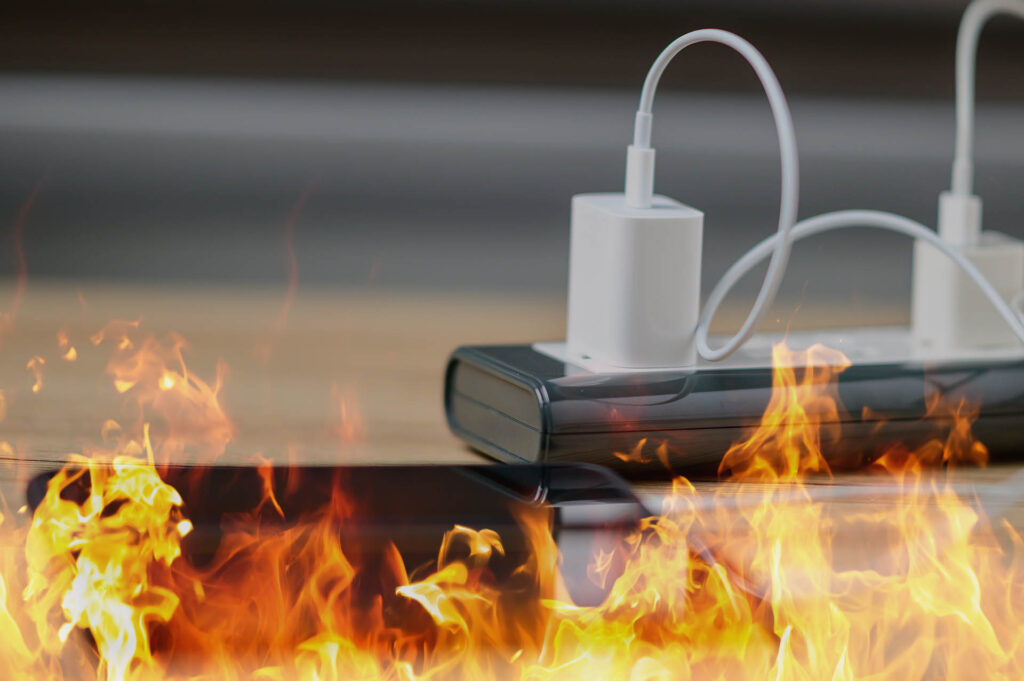
ASHEBORO, N.C. (ACME NEWS) — Every 95 seconds, a house fire is reported somewhere in the United States. With Fire Prevention Week under way, fire officials in North Carolina are drawing attention to a serious growing fire hazard that has creeped into nearly every aspect of modern life: lithium-ion batteries.
From October 5–11, the North Carolina Office of State Fire Marshal (OSFM) is joining fire departments nationwide in promoting Fire Prevention Week. First proclaimed by President Calvin Coolidge in 1925, Fire Prevention Week commemorates the Great Chicago Fire of 1871, which killed hundreds and destroyed thousands of buildings. Today, it remains the nation’s longest-running public health observance, promoting fire safety education and community preparedness. This year the National Fire Protection Association (NFPA) chose the theme, “Charge into Fire Safety: Lithium-Ion Batteries in Your Home.”
“Most families don’t realize just how many lithium-ion batteries are in their homes,” said State Fire Marshal Brian Taylor. “This year’s theme is about giving people the knowledge to use them safely, prevent fires, and protect their loved ones.”
Powering Modern Life — and New Risks
Lithium-ion batteries have become the default power source for modern life — found in smartphones, laptops, tablets, wireless earbuds, e-bikes, scooters, power tools, toys, vaping devices, and even electric vehicles. They’re also common in cordless vacuums, lawn equipment, and portable backup power packs.
They’ve largely replaced older nickel-based and alkaline batteries because they store more energy in a smaller, lighter package and can be recharged hundreds of times. But that same high-energy density also makes them more volatile if damaged, overheated, or charged improperly.
Inside each battery, thin layers of metal and flammable electrolyte fluid store energy in a tightly confined space. If that balance is disrupted — by overcharging, puncture, extreme heat, or an internal short circuit — the cells can undergo thermal runaway, a chain reaction that rapidly releases heat and gas. The result can be a sudden fire or explosion, often with little warning.
“Lithium-ion batteries power much of our modern lives,” said State Fire Marshal Brian Taylor. “Used properly, they’re safe — but one bad battery or one wrong charger can turn deadly in seconds. Fire safety starts with awareness.”
A May 2025 study in the peer-reviewed journal Fire Technology quantified how quickly these fires can turn deadly. Researchers with the Fire Safety Research Institute, part of UL Research Institutes, working with the New York City Fire Department, found that an e-scooter battery in thermal runaway could fully engulf a bedroom in flames within 30 seconds of the first visible smoke.
Closer to home, the North Carolina Office of State Fire Marshal (OSFM) cited an April 2025 fire in Calabash, where a family left a lithium-ion charger plugged in overnight. The battery — believed to power a scooter — overheated and exploded, igniting their detached garage. Flames spread rapidly, and the structure was fully engulfed before the family awoke. Local fire officials say the incident underscores how fast a hidden fault can escalate into a catastrophic blaze.
How to Stay Safe
The NFPA and U.S. Fire Administration (USFA) recommend several steps to reduce the risk of battery-related fires:
- Buy from reputable sources – Choose devices and batteries that display certification marks such as UL, ETL, or CSA — symbols showing the product has been independently tested for electrical and fire safety. Avoid cheap, off-brand chargers or replacement batteries, especially from unknown online sellers.
- Charge correctly and with the right charger – Always use the adapter and cord supplied with your device, and follow the manufacturer’s instructions. Charge devices on a hard, flat surface — never on beds, couches, or under pillows — and avoid leaving them plugged in overnight. If possible, charge large devices like e-bikes or power tools outdoors or in a well-ventilated area, away from doors and windows.
- Watch for warning signs – Stop using any device if the battery becomes swollen, hot, noisy, discolored, or emits an odor. If smoke or fire appears, call 911 immediately and, if safe, move the device away from anything that can burn.
- Recycle responsibly – Never throw lithium-ion batteries in household trash or curbside recycling bins.
Before recycling:
1. Tape the positive (+) terminal with clear or electrical tape.
2. Place each used battery in a clear plastic bag.
3. Take them to a certified collection site listed at Call2Recycle.org.
The U.S. Fire Administration also advises storing spare batteries in cool, dry areas and ensuring terminals don’t touch each other or metal objects.
###

